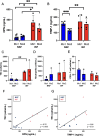Kidney function after liver transplantation: the contrasting roles of inflammation and tubular repair
- PMID: 39440014
- PMCID: PMC11493771
- DOI: 10.3389/frtra.2024.1480383
Kidney function after liver transplantation: the contrasting roles of inflammation and tubular repair
Abstract
Kidney injury is a significant complication in end-stage liver disease (ESLD), leading to increased morbidity and mortality. While liver transplant alone (LTA) can promote kidney recovery (KR), non-recovery associates with adverse outcomes, but the underlying pathophysiology is still unclear. We studied 10 LTA recipients with or without kidney failure (KF) and measured serum levels of OPN and TIMP-1 (previously identified predictors of KR), 92 proinflammatory proteins (Olink), and urinary cell populations. Our findings revealed elevated OPN and TIMP-1 levels in KF patients, strongly correlated with tubular epithelial cells in urine. Proteomic analysis showed distinct profiles in KF, non-KF, and healthy donors, indicating an ongoing proinflammatory signature in KF. Cytokines correlated with OPN and TIMP-1 levels. We propose that high pre-LTA OPN and TIMP-1 levels are crucial for tubular regeneration and normalize with kidney recovery. Insufficient pre-LTA OPN levels may lead to persistent kidney failure. Our present data also newly indicate that kidney failure post-LTA is an active condition, in which tubular cells are persistently shed in the urine. The strict association between systemic inflammation and tubular cell loss suggests a pathogenic link that could offer therapeutic opportunities to promote kidney recovery.
Keywords: OPN; TIMP-1; acute kidney injury; hepatorenal; liver transplant; tubular cell.
© 2024 Goerlich, Kim-Schulze, Kotanko, Grobe, Wang, Samans, Douglas, Enghard, Molinari, Fribourg, Cravedi and Levitsky.
Conflict of interest statement
PE holds a patent for preservation or urine cells (CHA124WOEP-UP). BS is employed at Precision for Medicine, a company offering molecular biology services. JD was employed by company Eurofins Viracor. The remaining authors declare that the research was conducted in the absence of any commercial or financial relationships that could be construed as a potential conflict of interest. The author(s) declared that they were an editorial board member of Frontiers, at the time of submission. This had no impact on the peer review process and the final decision.
Figures


References
LinkOut - more resources
Full Text Sources
Research Materials
Miscellaneous

